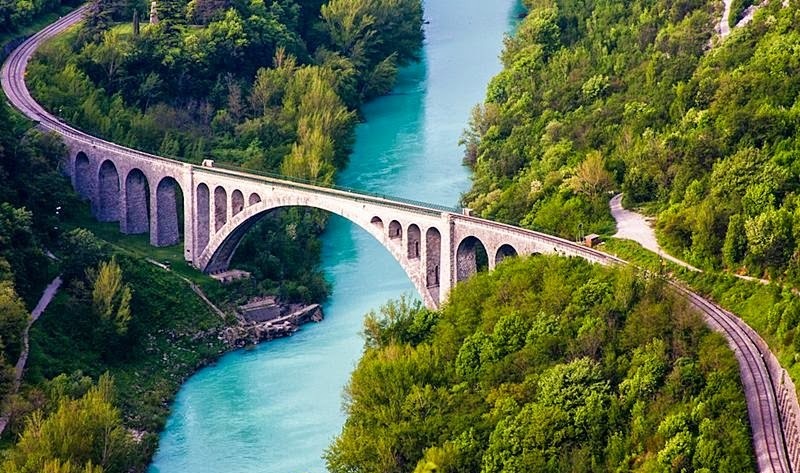
Our expert in slow travel explores the hidden delights of the Soča Valley and Julian Alps, all in a country where train fares have recently become more affordable.
James Bond rested until Sežana. In Ian Fleming’s ‘From Russia with Love,’ he describes Sežana as the place where ‘hard-faced Yugoslav plain-clothes men came on board.’ The Simplon-Orient-Express, famously used by James Bond, ceased operations in 1962, and the border encounters between former Yugoslavia and Italy ended with Slovenia joining the Schengen zone in 2007. Today, the railway station in Sežana, Slovenia, is a quiet outpost. The most intriguing departure of the day is the early-afternoon Eurocity train that travels east along the main line to Ljubljana, eventually reaching Vienna in the evening. While it offers a splendid journey, a hidden gem closer at hand is a remarkable rural railway that deserves wider recognition. The great news is that train fares in Slovenia were reduced in August.
Habsburg ambition
“We embark on a journey along an 80-mile railway, starting from Sežana and winding its way through stunning landscapes to reach Jesenice in the north-western corner of Slovenia. With the inauguration of the Suez Canal in 1869, Trieste, an Adriatic port, gained significant importance in the expansion of the Austro-Hungarian Empire’s maritime trade. However, the existing rail connections between Trieste and central Europe were operating at full capacity. Consequently, Habsburg planners began developing new railway routes from Trieste. The notion of crossing the Julian Alps faced ridicule from some quarters, and disagreements arose over the preferred routes. It wasn’t until 1906 that the first trains were able to traverse this line, connecting the coast to Jesenice.”
To the Soča valley
I observe the punctual departures of modern electric trains bound for Villa Opicina and Ljubljana before strolling to another platform where a diesel unit, covered in graffiti, patiently awaits. This platform hosts an infrequent service to Jesenice, a departure that I embarked upon as part of a four-day voyage from Rijeka in Croatia to Ribe in Denmark. Throughout this journey, I exclusively relied on slower trains, eliminating the need for advance reservations. The majority of passengers on the 10.10 train from Sežana to Jesenice have more modest travel plans, as this route primarily caters to local communities, accommodating short-distance travelers.
“The River Soča serves as a dramatic prologue to a magnificent journey north through the Soča valley, where the world’s longest stone-arch railway bridge spans its waters.”
Subsequently, the slopes become increasingly steep as we ascend the narrow Bača Valley. Following a brief halt at Podbrdo, we enter the four-mile-long Bohinj Tunnel, marking the pinnacle of this railway line. This tunnel serves as a significant geographic divide within Europe. Prior to entering the tunnel, our journey followed valleys that drained southward towards the Adriatic Sea. Upon emerging from the northern end of the tunnel, we find ourselves in the source region of the Sava River, which flows down to converge with the Danube in Belgrade, ultimately making its way to the Black Sea. The landscape undergoes a dramatic transformation as well, with a distinctly Alpine character emerging beyond the tunnel. This is the realm of the Julian Alps. To the left of the railway, the terrain rises steeply toward the majestic Triglav, towering at 2,864 meters as the highest peak in Slovenia.
Lake Bled and beyond
The railway plays a vital role in connecting isolated communities, operating special trains year-round that traverse the Bohinj Tunnel. This service allows for the transportation of vehicles in an area where roads present difficulties during the summer and become impassable due to heavy winter snow.
Departing from Bohinjska Bistrica, the railway station situated at the northern terminus of the Bohinj Tunnel, you can enjoy a delightful 20-minute journey aboard the leisurely train down the valley. The landscape unfolds with a touch of excitement as Slovenia’s renowned lake suddenly comes into view on the right.
This presents an enchanting approach to Lake Bled, where we disembark from the train and meander along a footpath through the forest leading to the lakeshore
Later, we continue our journey for the remaining 15 minutes until we reach the Jesenice terminus, where this secondary railway line connects with the main line running from Ljubljana to Villach in Austria’s Carinthia region. The once bustling furnaces and smelters of industrial Jesenice have fallen silent in recent times, lending the town a sense of being on the frontier. Austria lies just beyond the nearby hills. The town’s railway station, though now showing signs of neglect, was once celebrated as a bold example of modernist architecture. Erected in the mid-1950s, it served as the first point of entry into Yugoslavia for travelers arriving on international express trains from Austria. It witnessed the passage of countless individuals whose lives were influenced by the Cold War divide in Europe.
Travel facts
The journey from Sežana to Jesenice is most convenient on weekdays because, on weekends, there’s only one daily departure. From Monday to Friday, there are four Sežana-bound trains, with the 10:10 departure allowing for potential stopovers in the Soča Valley and at Lake Bled, while still arriving in Jesenice by early evening. The total travel time from start to finish, without any layovers, typically ranges from three to five hours.
The author of this account undertook this route as part of a more extensive travel plan, utilizing a four-day Interrail pass priced at €258 for an adult, with discounts available for individuals under 28 or over 60. Notably, train fares in Slovenia were reduced on August 11th. A one-way ticket from Sežana to Jesenice costs €10.70, and for those considering a round trip in a single day (which is feasible), the return fare now stands at just €14. Tickets can be purchased on the day of travel at station ticket counters or onboard the train. It’s important to note that due to recent flooding in Slovenia, buses might temporarily replace trains north of Bohinjska Bistrica until October 13th.



